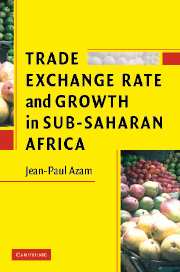Book contents
- Frontmatter
- Contents
- List of figures and tables
- Preface
- List of acronyms and abbreviations
- 1 Introduction and overview
- Part I Unrecorded trade in goods and currencies
- Part II Foreign exchange constraints
- Part III Longer-term growth in African countries
- 7 Exchange rate, growth, and poverty
- 8 Export crops, human capital, and endogenous growth
- 9 Ethnic rents and the politics of redistribution
- General conclusion
- References
- Index
7 - Exchange rate, growth, and poverty
Published online by Cambridge University Press: 26 May 2010
- Frontmatter
- Contents
- List of figures and tables
- Preface
- List of acronyms and abbreviations
- 1 Introduction and overview
- Part I Unrecorded trade in goods and currencies
- Part II Foreign exchange constraints
- Part III Longer-term growth in African countries
- 7 Exchange rate, growth, and poverty
- 8 Export crops, human capital, and endogenous growth
- 9 Ethnic rents and the politics of redistribution
- General conclusion
- References
- Index
Summary
Introduction
The decision to devalue the CFA Franc in January 1994 was probably one of the longest-awaited decisions in the modern history of adjustment policies. The exchange rate with the French Franc had not changed since 1948. While the performance of the CFA Zone economies had been much better than those of the other African economies until the collapse of most commodity prices in 1986–8, the latter had been undoubtedly much better at adjusting to these shocks (Devarajan and Rodrik, 1992). It was probably in 1989 that the need to devalue was the most acute, after the collapse of the TOT in most of the Zone at the end of 1987, and the decision by President Houphouët-Boigny of Côte d'Ivoire to withdraw the whole cocoa crop from the market in 1988; he tried single-handedly to support the world cocoa market, and ruined his country's creditworthiness (Azam and Morrisson, 1994). The impact of this worsening of the macro-economic situation on poverty can be analyzed only in the case of Côte d'Ivoire, among the CFA Zone countries, as none of the others has two household surveys performed at the relevant dates, allowing us to compare the outcomes before and after this shock.
- Type
- Chapter
- Information
- Trade, Exchange Rate, and Growth in Sub-Saharan Africa , pp. 173 - 196Publisher: Cambridge University PressPrint publication year: 2006



